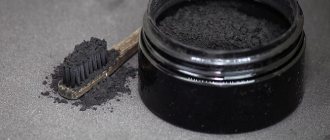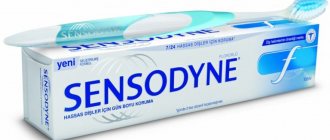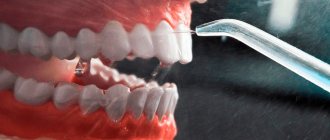Indications and contraindications Types After At home Is it harmful?
For children and pregnant women Differences from remineralization Effect Care after the procedure Fluoridation of teeth
- an effective way to protect teeth from caries and strengthen the enamel structure with the help of certain fluoridated agents.
Fluorine is an important element for the body; the daily requirement for it is about 3 mg. It comes to us with water and some food products. If it is not enough, then the connection between calcium compounds concentrated in the enamel is destroyed, the surface becomes vulnerable, which leads to increased sensitivity and damage to the tooth tissue.
Indications and contraindications
Indications for fluoridation of teeth in dentistry:
- increased sensitivity of enamel, reaction to cold, hot, sour and sweet foods;
- susceptibility to caries disease, as a preventive measure for caries;
- after using braces and other orthopedic structures;
- lack of fluoride;
- after teeth enamel whitening.
Contraindications for the procedure when there is only harm from fluoridation:
- allergy to fluoride-containing drugs;
- excess fluoride in drinking water;
- fluorosis (change in tooth color due to oversaturation of fluoride from childhood).
Types of fluoridation
There are two types of fluoridation: superficial and deep fluoridation of teeth.
Simple fluoridation of teeth
There are three simple methods used in dentistry:
- applying fluoride varnish to the tooth surface with a brush
. An invisible film is created. The procedure is repeated several times. The cost of fluoridation with varnish is affordable for everyone. Despite the fact that fluoride varnish therapy has been used for a long time, the remedy is still working and relevant. - electrophoresis
.
Better tissue permeability for fluoride molecules is achieved with small electrical pulses. At the first stage, electrodes impregnated with 10% calcium are attached to the teeth, at the second, this action occurs with sodium fluoride 2-4%. 10 procedures
are usually enough. - individual mouth guards
filled with a fluoride-containing preparation.
They are made quickly during a visit to the dentist, an impression is taken and the trays harden to the shape of the patient’s teeth. The material is elastic. The doctor fills the trays with a solution containing a photor. The patient puts them on for 5-10 minutes. 10 procedures
are recommended .
Deep fluoridation of enamel and dentin
A simple method is superficial; fluorine particles are large and cannot penetrate deeply. Deep fluoridation of teeth uses a solution of magnesium fluoride silicate whose molecular size is so small that the product acts deeper in the tissues, enriching them with a higher concentration of fluoride. Fluorine and calcium create strong crystalline bonds. At the end of the procedure, the teeth are coated with a “sealing” preparation. Fluoride compounds remain under it for a year and a half.
Conduct deep fluoridation up to twice a year
, not more often. The effect of this method compared to the simple one is 5 times higher.
How do toothpastes work to restore enamel?
Anyone who cares about dental health has probably asked the question more than once: “how can you strengthen tooth enamel?”
If your teeth have become sensitive or stains have appeared on your teeth, this is certainly a reason to consult a doctor, sort out the problems and choose treatment; home care may not be enough; serious in-office remedies may be needed.
However, as a preventative measure, strengthening the enamel is possible with the help of properly selected toothpastes. To understand, we will first delve a little deeper into chemistry.
Let's understand the processes in tooth enamel, pay attention to the composition of toothpastes, and by combining this knowledge, you will be able to choose your own toothpaste to restore teeth, but do not forget to consult with your doctor.
So, tooth enamel is the hardest tissue, which consists of 96% of inorganic mineral compounds - phosphorus, fluorine, calcium and other components. But despite her hardness, she is quite vulnerable. To find out why, let's delve a little deeper into chemistry.
The main compound of enamel is hydroxyapatite, and few people know that in the surface layer of enamel, hydroxyapatite crystals undergo constant changes. When the pH of saliva becomes acidic (in other words, teeth are not brushed), the hydroxyl group from our hydroxyapatite turns into water!
The crystal lattice is broken, calcium is released, and the vulnerability of the enamel to acids has increased. This is the process of demineralization of enamel at the molecular level. If there is an excess of calcium or phosphorus ions in the periodontal environment, then the reverse process will begin - mineralization.
What about fluoride? And fluorine ions form a modification - hydroxyfluorapatite is a fairly acid-resistant compound, and in high concentrations calcium fluoride is a generally insoluble compound.
In conditions of healthy oral microflora and normal saliva composition, the natural processes of demineralization and remineralization occur constantly and ensure a balanced mineral balance of tooth enamel.
The source of calcium and phosphate ions is saliva, and poor hygiene and poor nutrition contribute to the proliferation of bacteria, which in turn contribute to the accumulation of acids in the oral cavity.
So daily brushing of teeth is not just a hygienic procedure, it is a war for the strength and durability of the enamel of your teeth.
Indications for strengthening enamel
- The main indications for strengthening tooth enamel are:
- Caries at any stage.
- Baby teeth.
- Pregnancy and breastfeeding period.
- Discomfort or toothache while eating.
- Time before and after teeth whitening procedure.
- Orthodontic treatment (braces).
- Chips, scratches and cracks on teeth.
- Bite abnormalities and, as a result, pathological abrasion.
- Long-term drug therapy.
How do toothpastes work to restore enamel?
Most researchers agree that the main source of substances entering the enamel is oral fluid. There is also a very important detail: enamel has high permeability, due to the presence of microspaces filled with water through which various substances can penetrate, depending on their radius and activity. For example, the fluoride ion is large and active, therefore it is embedded quickly and only into the surface layers of the enamel, while the calcium ion is the opposite, so it manages to penetrate much deeper.
All this was proven through long-term research and based on these details, remineralization schemes were created - artificial saturation of tooth enamel with minerals.
Since ions penetrate the enamel through a slow diffusion process, remineralization requires time and therefore multiple manipulations.
Most of all, tooth enamel needs an element such as calcium. The strength and hardness of teeth depends on it. Calcium-containing pastes are suitable for restoring the enamel layer with minor damage. They contain various calcium compounds that penetrate dental tissue, strengthen and restore them.
Toothpastes with calcium are especially useful for primary signs of demineralization. Damaged enamel, which may periodically show itself with increased sensitivity, needs to be healed with pastes containing active calcium;
In case of serious damage to the enamel layer, it is recommended to use fluoride-containing pastes. Pastes containing fluoride, when cleaning the oral cavity, actively react with calcium ions, filling microcracks and damage to the enamel.
Penetrating into the enamel layer, the substances are integrated into the structure of the tissue, restoring and strengthening it.
It is useful to alternate fluoride-containing paste and calcium paste. It is undesirable for both components to be present in one tube, since together they form an insoluble salt. Because of this, when brushing your teeth, active fluoride and calcium ions will not be released from the paste, so there will be no benefit from such therapeutic cleaning. Modern research does not stand still, constantly modifying and improving the compositions of toothpastes. But there are still “old” toothpastes on the market that do not provide any benefit to teeth. I recommend carefully studying the composition of toothpastes and consulting with your dentist; some of them are reliable and proven
Toothpastes for restoring enamel with calcium
We have already seen that calcium ion has very weak activity. Therefore, it is very important that its form in toothpaste is easily absorbed by tooth enamel.
Calcium in toothpastes can be contained in the form of the following compounds:
- Calcium citrate.
- Calcium pantothenate.
- Calcium lactate.
- Hydroxyapatite.
Very often you can find a combination of two or three of these calcium compounds in toothpaste, which, of course, increases the chances of calcium being incorporated into the tooth enamel, and therefore strengthening the teeth.
Calcium citrate replenishes calcium deficiency in the body and is safe to swallow. The calcium in this compound easily penetrates tooth enamel, strengthening and protecting it.
Calcium pantothenate is a widespread calcium compound present in the body and actively involved in metabolism. It enriches teeth with essential calcium and is safe when ingested.
Calcium lactate is used in the food industry to fortify foods with calcium and as a substitute for table salt. It is perfectly absorbed by the body and protects against caries.
“Good old” calcium glycerophosphate. It has been established that toothpastes based on calcium glycerophosphate effectively remove plaque, stabilize the cariogenic situation in the oral cavity and do not have a sensitizing effect on the body. Pastes containing calcium glycerophosphate are time-tested, affordable and reliable. For all conservatives for complex therapy of superficial caries.
For those who love innovation.
Nanotechnology has reached toothpastes. Hydroxyapatite itself is by no means an innovation in dentistry. Experiments on its use took place at the beginning of the 20th century, but only at the end did Japanese scientists manage to develop nanocrystalline medical hydroxyapatite. This artificially synthesized form is maximally biocompatible and bioactive.
Over time, the formula has been improved, the particles have decreased, and today toothpastes containing nanohydroxyapatite are leading in the prevention of caries. Its effectiveness has been proven in the initial stages of caries, due to the ability of ions to penetrate into the microscopic spaces between enamel prisms, embedding themselves in the crystal lattice of hydroxyapatite crystals of tooth enamel. As a result, tooth enamel is restored.
Toothpastes with nanohydroxyapatite eliminate caries at the white spot stage and “seal” microcracks; reduce tooth sensitivity.
An indispensable assistant at the first signs of problems with tooth enamel.
Another contender for special treatment
Amorphous calcium phosphate. When in contact with saliva and hydroxyapatite, this element forms a special biofilm on the surface of the teeth, which: protects the enamel from the harmful effects of acids and ensures the connection of bioavailable calcium with the enamel, accelerating its remineralization.
Important! Since the active substance is obtained from cow's milk casein, this method of strengthening enamel is not suitable for people with allergies to milk protein.
Theobromine is for lovers of natural and maximally safe, expensive and chic. Theobromine (cocoa bean extract) acts as a catalyst; it stimulates the formation of its own hydroxyapatite crystals, providing natural remineralization of enamel. Calcium acetate serves as a building material for the crystal lattice of tooth enamel.
The enamel becomes denser and more resistant to acids. Studies have confirmed the beneficial effects of theobromine on tooth enamel and its high effectiveness in combating tooth sensitivity.
Please note that forms of calcium not listed above are merely abrasives in toothpaste (for example, calcium carbonate or dicalcium phosphate). Therefore, when choosing a toothpaste to strengthen your teeth enamel, be guided by the calcium compounds described above, or consult your dentist.
Toothpastes for strengthening enamel with fluoride
Every person knows: fluorides protect teeth from caries! But there is other known information - fluoride is toxic to the body. How to be? Who to believe? Let's figure it out.
In our body, elements such as fluorine and calcium are divided into macroelements, there should be a lot of them, and microelements, they are needed, but in small quantities. For example, the daily calcium intake for an adult is 1000-1200 mg. While the norm for fluoride is only 4 mg. But, did you know that with an excess of calcium and vitamin D in the body, the risk of urolithiasis increases. And excess iron in the blood also causes toxic effects and is called iron overload syndrome. And so the list can be endless.
Important! Everything useful is useful in moderation! Same with fluorine.
How to understand whether it is needed and whether it will not be harmful?
First of all, determine what fluoride content is in the water in the region where you live. Since we get the most fluoride from drinking water. You can find up-to-date information about fluoride levels in water in your area on the website of your local water utility.
In Russia, the fluorine content in water from natural sources is usually low - less than 0.5 mg/l. Only in the groundwater of the Tver, Moscow, Ryazan, Sverdlovsk and Chelyabinsk regions the concentration of fluorine is increased (reaches 4.4 mg/l). There is also a list of regions where, due to large production, the fluoride content is also increased.
Only in regions with high levels of fluoride in water are toothpastes with fluoride contraindicated. Everyone else needs and benefits from fluoride in the right dosages.
What are the benefits of fluoride?
Fluoride performs important tasks in the body.
- Together with phosphorus and calcium, it participates in the formation and strengthening of bone tissue and tooth enamel.
- Promotes healthy nail and hair growth.
- Stimulates hematopoietic processes: formation, development and maturation of red blood cells, platelets and leukocytes.
- Strengthens the immune system and maintains it at an appropriate level.
- Removes salts of radionuclides and heavy metals from the body.
- When used in oral care products, fluoride helps prevent dental problems and solve existing ones.
- Prevent tooth decay. Fluoride penetrates the enamel structure, prevents caries and treats it at the white spot stage.
- Protect against demineralization. The combination of fluorine with hydroxyapatite forms fluorohydroxyapatite, a substance that reduces it. This is how enamel remineralization occurs.
- Protect against lactic acid. Fluoride prevents bacteria from producing lactic acid. This reduces the growth of pathogenic microflora and gives the enamel additional protection.
Why is fluoride deficiency dangerous in the body?
Fluorine deficiency in the body is most often caused by its low content in drinking water (less than 0.7 mg/l). Another possible cause is improper regulation of fluoride metabolism in the body. A deficiency of this substance weakens tooth enamel, making it more vulnerable to caries. A child with a lack of fluoride may experience delayed ossification and defects in bone mineralization. In an adult, with prolonged deficiency, the risk of developing osteoporosis increases.
If there is too much fluoride in the body
Fluoride is found not only in oral care products and tap water, but also in food. The maximum permissible daily intake for an adult is 10 mg. An excess of fluoride is more dangerous for the body than a deficiency, as it entails irreversible processes. First of all, teeth and bones are affected; metabolic disorders, deterioration of blood clotting, etc. may occur. In children, even before teething, endemic fluorosis develops - this is a chronic lesion of tooth enamel in the form of spots of various sizes, shapes and colors. After 10–20 years of excess fluoride in the body, bone fluorosis develops, which can develop into osteosclerosis, osteoporosis and osteosarcoma (malignant formation). As a rule, we are talking about excess fluoride entering the body for a long time with water and food or, for example, toxic production. It is also possible that fluoride metabolism in the body is impaired, which is rare.
Is fluoride from toothpaste harmful?
We figured out that the toxic effect of fluoride, which some fear, is due only to ingestion. Should you be afraid of fluoride toothpaste? No! When brushing our teeth, we do not swallow toothpaste. And fluorine, as we remember, an element with high activity, quickly reacts with hydroxyapatite of tooth enamel, settling in its surface layers and does not have time to penetrate through the tooth into the bloodstream. This means that when brushing your teeth 2 times a day, toothpaste with fluoride does not cause any harm. And the concentrations of fluoride in toothpastes are strictly limited. The amount of fluoride in ppm is usually indicated on the packaging. The abbreviation ppm stands for parts per million and reflects the number of fluorine particles per million. If the tube states that the toothpaste contains 900 ppm of fluoride, this means that 1 kg(!) of toothpaste will contain 900 mg of this element.
The higher the fluoride concentration, the better the paste restores enamel. For prophylactic pastes it is 900-1150 ppm, for therapeutic and prophylactic pastes it is 1350–1500 ppm. There are products with higher content, but they are used only as prescribed by a doctor and in short courses. As a reminder, these recommendations are suitable for anyone living in areas with moderate levels of fluoride in their drinking water.
Can children have fluoride toothpaste?
The European Academy of Pediatric Dentistry (EAPD) recommends fluoride pastes and gels for everyone - even children and pregnant women - to prevent early stages of tooth decay.
Recommended fluoride content in toothpaste:
- up to 4 years - 200 ppm;
- from 4 to 8 years - 500 ppm;
- over 8 years old and for adults - 1450 ppm.
Fluoride is an important component in caring for children's teeth. However, if the toothpaste is swallowed frequently, fluoride accumulates in the body and can cause unpleasant consequences. Important! The child brushes his teeth under the supervision of an adult!
Children can begin brushing their teeth with fluoride-containing toothpastes when their first tooth erupts. Because the recommended amount of toothpaste when brushing your teeth is a grain of rice. And the amount of fluorine is 200-250ppm. That is, it is 200 mg in 1000 mg paste. Tube with children's toothpaste 50ml. Even if we roughly translate, without taking into account the density of the substance, that ml is equal to mg, then we get 10 mg of fluorine. It turns out that for the toxic effect of fluoride to manifest itself, the child must eat the entire tube of toothpaste at one time! Agree, if a child eats a whole tube of cream or anything else, this will also cause problems. Therefore, it is recommended to keep any attractive tubes away from children. And the child brushes his teeth under adult supervision.
How do fluorides affect enamel?
Fluoride ions interact with calcium ions, forming calcium fluoride, which is built into the structure of tooth enamel, restoring and strengthening it. Therefore, in order to fix calcium in the teeth and slow down the carious process, it is recommended to use fluoride-containing products to restore teeth. After all, as we discussed at the beginning of the article, hydroxyfluorapatite is a more acid-resistant compound, and calcium fluoride is insoluble, which means that enamel with such structural elements is stronger and less susceptible to caries. In addition, fluorine has a bacteriostatic effect, which helps to heal the microflora. This is why fluoride toothpastes are so popular among dentists.
However, all fluorine-containing additives have their own characteristics and differ in the speed of action. For example, amino fluoride, which is an organic fluorine compound, forms a persistent protective film on the surface of the enamel. Inorganic fluorine compounds (sodium fluoride and others) also form a protective film, but under the influence of saliva it dissolves faster.
As in the story with calcium, we pay attention to the composition.
Sodium monofluorophosphate. Today it is rare, in old-style toothpastes. It excludes all fluoride compounds. It does not contain fluorine ion, but a solid compound that does not dissolve as easily as ionic compounds. This compound was the result of creative work by chemists as a solution to the problem of combining calcium and fluorine.
What happens to this compound in the oral cavity remains unclear even to the scientists themselves who studied this topic. Some claimed that the element immediately binds to tooth enamel, others said that upon contact with enzymes in saliva, fluoride ion is released. But the secret remained not fully revealed!
Sodium fluoride is the most common supplier of fluoride. It is the simplest fluoride compound: fluorine ion and sodium ion, which are tightly bound to each other due to their charge. Thus, sodium fluoride is a salt that dissolves very easily in water, as well as in saliva (although not as well as regular table salt). Sodium fluoride supplies tooth enamel with fluoride ions, and thereby overcomes the first step in the prevention of caries.
Aluminum fluorides
Also a salt, as in the case of sodium fluoride, but has limited solubility in water, similar to calcium fluoride. Thus, since fluoride ions have a cariesstatic effect, the prospects for protection when using aluminum fluoride compounds are very limited.
For this reason, preference for choosing a product based on it remains minimal.
Zinc fluorides - today only in combination with other fluoride compounds.
Zinc fluoride is also a salt, easily soluble in water. In principle, a good candidate for joining the ranks of toothpaste formulations. Indeed, the first toothpaste with fluoride was based on zinc fluoride, a well-known American brand. But highly reactive zinc ions tend to cause problems! Therefore, the creators are forced to resort to some secrets to stabilize it. This has caused most manufacturers to switch to the more stable sodium fluoride.
In recent years, zinc fluorides have been experiencing a renaissance! Since in combination with amino fluorides they form a stable and effective chain.
Aminofluorides are the product of targeted development and long research!
Amino fluorides are also salts, but compared to sodium fluorides they have a more complex structure. They were the result of a focused search for the best compound to protect teeth from caries. The fluorine ion in the case of amino fluorides is bound into a complex amine molecule by fatty acid hydrolase. The peculiarity of these compounds is their bipolarity: on the one hand, the polar amine base is soluble in water, on the other hand, the nonpolar base is fatty. Such compounds become active on the surface, enveloping it.
| Component | Name on the tube | A comment |
| Sodium monofluorophosphate | Sodium monofluorophosphate | It is ineffective because due to the rate of decay it begins to act only after 3–4 minutes of cleaning. |
| Sodium fluoride | Sodium fluoride | Has a powerful antibacterial and restorative effect. The active substance reduces the ability of bacteria to convert sugar into acid, which destroys enamel. |
| Aminofluoride | Aminofluoride/Olaflur | Recognized as the most effective for caries prevention. Forms a protective film on the surface of the teeth, from which fluoride enters the enamel and strengthens it. |
| Tin fluoride | Stannous fluoride | It is proven effective, but has a side effect: it first lightens the restored areas of enamel, and then leads to their noticeable darkening. |
For home care and caries prevention, you can use toothpastes with fluoride; the most effective are those containing sodium fluoride and amino fluorides. The higher the fluoride content, the better the remineralizing properties of the paste and the protection against caries. But it is better not to use high dosages without a doctor’s prescription.
Fluoride and calcium are equally important for enamel remineralization. However, we remember that when combined they form an insoluble salt and neutralize each other’s effects. Now some manufacturers are trying to get around this problem. In the meantime, follow the proven scheme: alternate the use of pastes with calcium and fluoride.
Which toothpaste is best for strengthening enamel?
Of course, the one that suits you. When making a choice, you should not listen to commercials or the advice of friends.
The state of dental health varies from person to person. Advice from a dentist after a routine examination of the oral cavity will certainly help you decide on the right choice of toothpaste with active ingredients for the restoration and prevention of tooth enamel.
Proper nutrition, regular oral hygiene procedures and the use of only high-quality and highly effective toothpastes will help strengthen the enamel and maintain the health of your teeth.
Is it possible to do fluoridation at home?
The price of dental fluoridation in Moscow using the deep method will cost 2000-3000 rubles (all teeth), but you can do it yourself. Preparations for fluoridation at home are freely sold in pharmacies and specialized stores.
- Fluoride varnish
. Follow strictly the instructions, which indicate how and how many times to apply fluorine-containing varnish. - Therapeutic and prophylactic pastes and gels
. The composition should contain sodium fluoride, amino fluoride and other fluorides. We must remember that you cannot use such a paste for a long time so that there is no excess of fluoride in the body. Be sure to alternate with other types.
For effective fluoridation, it is better to consult with your dentist about choosing medications for home use. The result will be more lasting if you have professional teeth cleaning done beforehand to remove plaque and tartar.
Clinical researches
Repeated clinical studies have proven that regular use of preventive toothpaste ASEPTA ACTIVE for a month can reduce bleeding gums by 60%, improve the overall condition of the oral cavity by 44% and reduce inflammation by 33%.
Sources:
- Clinical and laboratory assessment of the influence of domestic therapeutic and prophylactic toothpaste based on plant extracts on the condition of the oral cavity in patients with simple marginal gingivitis. Doctor of Medical Sciences, Professor Elovikova T.M.1, Candidate of Chemical Sciences, Associate Professor Ermishina E.Yu. 2, Doctor of Technical Sciences Associate Professor Belokonova N.A. 2 Department of Therapeutic Dentistry USMU1, Department of General Chemistry USMU2
- Clinical studies of antisensitive toothpaste “Asepta Sensitive” (A.A. Leontyev, O.V. Kalinina, S.B. Ulitovsky) A.A. LEONTIEV, dentist O.V. KALININA, dentist S.B. ULITOVSKY, Doctor of Medical Sciences, Prof. Department of Therapeutic Dentistry, St. Petersburg State Medical University named after. acad. I.P. Pavlova
- Clinical experience in using the Asepta series of products Fuchs Elena Ivanovna Assistant of the Department of Therapeutic and Pediatric Dentistry State Budgetary Educational Institution of Higher Professional Education Ryazan State Medical University named after Academician I.P. Pavlova of the Ministry of Health and Social Development of the Russian Federation (GBOU VPO RyazSMU Ministry of Health and Social Development of Russia)
Differences from remineralization
Any method of dentin fluoridation is part of remineralization, artificial saturation of the enamel structure with micro- and macroelements by applying dental pastes, gels rich in calcium, fluorine, phosphorus, magnesium, zinc, etc. to the surface. The procedures have the same goal - prevention of caries, strengthening of enamel and replenishment microelements lost during demineralization. If pastes and gels for remineralizing dental tissue contain several components, then fluoridation agents contain fluoride ions.
Fluoridation increases the rate of remineralization several times. Since fluoride varnish seals dentinal tubules, the use of mineral complexes should be separate. First, remineralization, the final stage is fluoridation of teeth.
How does fluoride affect teeth?
Whether fluoride is beneficial or harmful to teeth - there is no definite answer. The human body needs this substance only in a reasonable amount, otherwise it can cause the formation of various diseases.
Fluoride performs the following functions in the body:
- It is a preventative against oral diseases, such as caries and periodontal disease.
- Takes part in the process of formation of tooth enamel.
- Actively cleans hard dental tissues.
- Has antibacterial properties.
- Has a positive effect on the soft tissues of the oral cavity.
Effect of fluoridation
Although tooth enamel contains less fluorine than calcium, it is simply necessary for the strength of the enamel. When fluoridating dentin, fluorine combines with tissue molecules and forms fluorapatite hydroxide, which is more resistant to acids. Namely, acids (acidic foods, waste products of bacteria in dental plaque) destroy tooth tissue, demineralization occurs, and micro- and macroelements that play an important role are washed out. Timely fluoridation of dentin prevents this process.
After the procedure:
- enamel becomes stronger;
- natural shine appears;
- susceptibility to caries is minimized;
- Calcium and phosphorus are better absorbed by dental tissue and retained there;
- enamel sensitivity decreases.











